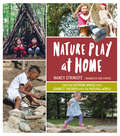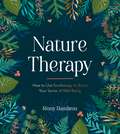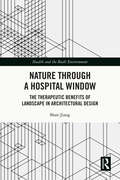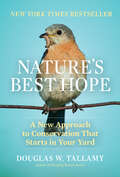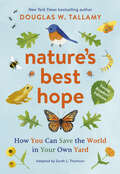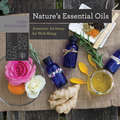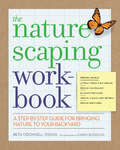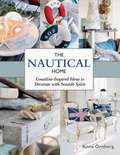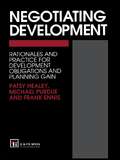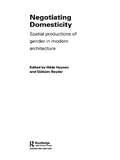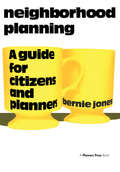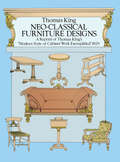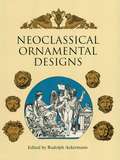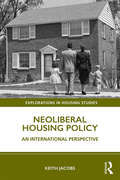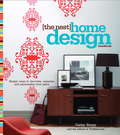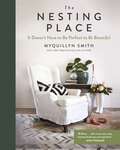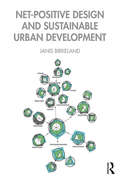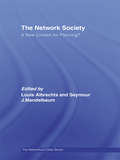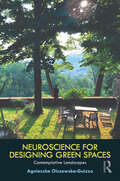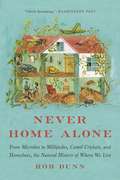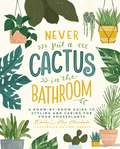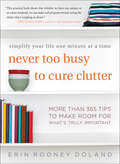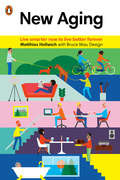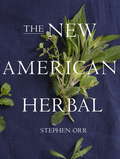- Table View
- List View
Nature Play at Home: Creating Outdoor Spaces that Connect Children with the Natural World
by Nancy Striniste“A magnificent resource for transforming backyards into stimulating environments which enhance children’s creativity, learning, and fun.” —Richard Louv, author of Last Child in the Woods, The Nature Principle, and Vitamin N Access to technology has created a generation of children who are more plugged in than ever before—often with negative consequences. But there is a solution. Unrestricted outdoor play helps reduce stress, improve health, and enhance creativity, learning, and attention span. In Nature Play at Home, Nancy Striniste gives you the tools you need to make outdoor adventures possible in your own backyard. With hundreds of inspiring ideas and illustrated, step-by-step projects, this hardworking book details how to create playspaces that use natural materials—like logs, boulders, sand, water, and plants of all kinds. Projects include hillside slides, seating circles, sand pits, and more.
Nature Therapy: How to Use Ecotherapy to Boost Your Sense of Well-Being
by Rémy DambronNature therapy is the practice of reconnecting with the natural world to refresh your physical and mental well-being. Including tips to help you discover your connection with the outdoors, activity inspiration and a holistic approach to wellness, this book is the ultimate guide to unlocking the transformative power of nature.
Nature Therapy: How to Use Ecotherapy to Boost Your Sense of Well-Being
by Rémy DambronNature therapy is the practice of reconnecting with the natural world to refresh your physical and mental well-being. Including tips to help you discover your connection with the outdoors, activity inspiration and a holistic approach to wellness, this book is the ultimate guide to unlocking the transformative power of nature.
Nature through a Hospital Window: The Therapeutic Benefits of Landscape in Architectural Design (Health and the Built Environment)
by Shan JiangAdopting an evidence-based approach, this book uses two state-of-the-art experimental studies to explore nature’s therapeutic benefits in healthcare environments, emphasizing how windows and transparent spaces can strengthen people–nature interactions. High-quality, supportive, and patient-centred healthcare environments are a key priority for healthcare designers worldwide, with ageing populations creating a demand for remodeled and updated facilities. The first study demonstrates individual psychophysiological responses, moods, and preferences in simulated hospital waiting areas with different levels of visual access to nature through windows, while the second experiment uses cutting-edge immersive virtual reality techniques to explore how gardens and nature views impact people’s spatial cognition, wayfinding behaviors, and experience when navigating hospitals. Through these studies and discussions drawing on architectural theory, the book highlights the important benefits of having access to nature from hospital interiors. This concise volume will appeal to academics and designers interested in therapeutic landscapes and healthcare architecture.
Nature's Best Hope: A New Approach to Conservation that Starts in Your Yard
by Douglas W. Tallamy&“Tallamy lays out all you need to know to participate in one of the great conservation projects of our time. Read it and get started!&” —Elizabeth Kolbert, Pulitzer Prize-winning author of The Sixth Extinction Douglas W. Tallamy&’s first book, Bringing Nature Home, awakened thousands of readers to an urgent situation: wildlife populations are in decline because the native plants they depend on are fast disappearing. His solution? Plant more natives. In this new book, Tallamy takes the next step and outlines his vision for a grassroots approach to conservation. Nature&’s Best Hope shows how homeowners everywhere can turn their yards into conservation corridors that provide wildlife habitats. Because this approach relies on the initiatives of private individuals, it is immune from the whims of government policy. Even more important, it&’s practical, effective, and easy—you will walk away with specific suggestions you can incorporate into your own yard. If you&’re concerned about doing something good for the environment, Nature&’s Best Hope is the blueprint you need. By acting now, you can help preserve our precious wildlife—and the planet—for future generations.
Nature's Best Hope (Young Readers' Edition): How You Can Save the World in Your Own Yard
by Douglas W. TallamyThis middle grade edition of the groundbreaking bestseller by Doug Tallamy will inspire kids to use their backyard to help save the planet. Douglas W. Tallamy awakened thousands of readers to an urgent situation: wildlife populations are in decline because the native plants they depend on are fast disappearing. His solution? Plant more natives. In this middle grade adaptation of the New York Times bestseller Nature's Best Hope, Tallamy outlines his vision for a grassroots approach to conservation that everyone can participate in regardless of age. In Nature's Best Hope (Young Readers' Edition), Tallamy empowers kids to use their own yards to help combat the negative effects of climate change. He does so by breaking down complex concepts into simple terms and real-world examples that kids can easily grasp. Black and white photographs help further clarify concepts. In addition to sharing the science, Tallamy encourages kids to take direct action. Some of these ideas include planting an oak tree (one of the most important tree species) at home. If that&’s too large of a task, he suggests they can plant asters—a beautiful flower whose pollen bees use to feed their young. By helping the next generation see that they have power and agency over our collective future, this empowering book will drive home the positive point that kids are truly nature&’s best hope.
Nature's Essential Oils: Aromatic Alchemy For Well-being (Countryman Know How #0)
by Cher KaufmannLavender is calming and relaxing; lemon uplifting and stimulating. But why do each of these scents provoke specific, visceral responses? In Nature’s Essential Oils, certified aromatherapist Cher Kaufmann demystifies the how and why behind essential oils, explaining the environmental factors that impact the chemical make-ups of herbs and plants and how they trigger our physical and emotional responses. This thorough and welcoming guide includes recipes for oil blends that can be used in diffusers and personal inhalers as well as for bath salts, salves, linen sprays, and more. Kaufmann also explains essential oil dilution and safety, shares the best carrier oils for each application, and includes tips for buying and storing oils. With detailed profiles of more than 30 of the most common essential oils for well-being, this is a valuable resource for anyone hoping to expand their knowledge of essential oils and their properties.
The Naturescaping Workbook: A Step-by-Step Guide for Bringing Nature to Your Backyard
by Beth O'Donnell Young Karen BussoliniMuch of modern garden design is about controlling nature to achieve a desired effect. But for the eco-conscious homeowner, the best garden designer is Mother Nature, and following her lead can result in a beautiful low-maintenance landscape that requires fewer resources, attracts natural wildlife, and saves time and money. In The Naturescaping Workbook, author Beth O'Donnell Young sets forth an easy-to-follow, do-it-yourself plan for gardeners of all skill levels. Her step-by-step approach teaches gardeners to understand their own natural habitat and to nurture the native eco-systems that exist in their yard. And the payoff is huge. By simply becoming aware of the natural wonders in the backyard, anyone can gain a more beautiful garden and take a big step toward bringing nature home.
The Nautical Home: Coastline-Inspired Ideas to Decorate with Seaside Spirit
by Anna OrnbergAre you a beach bum, a beach lover, or simply just a fan of the water? If you find yourself constantly longing for a relaxing vacation along the sandy shores of Tahiti or yearning to go on a coast-to-coast cruise, look no further. Interior designer Anna Örnberg has all the solutions to bring the waves to your home and living room. With Anna’s advice and expertise, you can turn your own apartment or living space into a beautiful waterfront home. Live on the beach with nautical style and enjoy the waves. Using seashells, ropes, dark woods, and light-colored walls, the interior designs in this book remind readers of sunken ships and buried treasures. The decor will inspire homeowners to personalize their homes into the most calming and soothing living quarters, a place where they can sit, relax, and enjoy the ocean breeze. Projects include: Wooden lampshades Nautical placemats and pot holders Building your own lighthouse Beanbags and pillowcases The nautical look is a classic theme that suits a wide audience. Whether you’re looking for new ideas to spruce up your city center apartment or looking to decorate your holiday vacation home, this book has the answers. The Nautical Home has a little something for everyone, from the average homeowner hoping to reinvent a room or more to the recent college grad looking for new ways to decorate a new home. With the interior designs in this book, you can finally be the captain of your own ship or home.
Negotiating Development: Rationales and practice for development obligationsand planning gain
by F. Ennis Frank Ennis P. Healey Prof Patsy Healey M. PurduePlanning gain is the legal process by which property development is linked to social provisions. This book examines the rationale for planning gain and development obligations and reviews the practice of development negotiation through a wide range of case histories.
Negotiating Domesticity: Spatial Productions of Gender in Modern Architecture
by Hilde Heynen Gülsüm BaydarIn the home the intricate relations between architecture, gender and domesticity become visible. Negotiating Domesticity investigates the many and complex themes evoked by the interconnections between these terms. Topics covered include famous as well as less well-known architectural examples and architects, which are explored from sociological, anthropological, philosophical and psychoanalytical approaches. The authors explore the relationships between modern domestic spaces and sexed subjectivities in a broad range of geographical locations of Western modernity. This richly interdisiplinary work presents architects and postgraduate students with an in-depth exploration of domesticity in the modern era.
Neighborhood Planning: A Guide for Citizens and Planners
by Bernie JonesFirst published in 1990. Routledge is an imprint of Taylor & Francis, an informa company. This guide explains neighborhood planning for both citizens and professionals. It explains what information to collect, where to get it, and how to assess it; how to pinpoint key issues, set clear goals, and devise strategies to achieve them; and how to package, implement, and update the final plan. Although this book could be used by citizens working alone, Jones advocates a team approach—citizens and professionals planning together. He highlights which tasks are best suited to the professional and how the planner should manage his role as intermediary between the city administration and residents. Jones also takes a detailed look at the neighborhood plan itself. Numerous maps illustrate how to inventory environmental features, land uses, circulation systems, and design features.
Neo-Classical Furniture Designs: A Reprint Of Thomas King's Modern Style Of Cabinet Work Exemplified, 1829
by Thomas KingInfluential guide displays over 300 Grecian designs: fire screens, sofas, couches, chairs, footstools, commodes, sideboards, washstands, bedsteads,and many other items.
Neoclassical Ornamental Designs
by Rudolph AckermannGraphic artists, illustrators, desktop publishers - anyone in search of elegant classical ornament - will find a wealth of usable material in this handy resource, reproduced from rare 19th-century portfolios. Readers can choose from borders, corners, vignettes, cartouches, busts, ornamental designs, and many other configurations depicting gods and goddesses, mythical animals, floral and foliate motifs, urns, chariots, helmets, angels and cherubs, columns, figures from classical mythology, and more - all in fine-line renderings that convey a sense of timeless elegance and classical ambience. Ideal for adding pictorial interest to book and magazine illustrations, advertisements, brochures, and many other projects, these designs comprise an easy-to-use, copyright-free reference that belongs at the fingertips of anyone wishing to create eye-catching graphics with a classical touch.
Neoliberal Housing Policy: An International Perspective (Explorations in Housing Studies)
by Keith JacobsNeoliberal Housing Policy considers some of the most significant housing issues facing the West today, including the increasing commodification of housing; the political economy surrounding homeownership; the role of public housing; the problem of homelessness; the ways that housing accentuates social and economic inequality; and how suburban housing has transformed city life. The empirical focus of the book draws mainly from the US, UK and Australia, with examples to illustrate some of the most important features and trajectories of late capitalism, including the commodification of welfare provision and financialisation, while the examples from other nations serve to highlight the influence of housing policy on more regional- and place-specific processes. The book shows that developments in housing provision are being shaped by global financial markets and the circuits of capital that transcend the borders of nation states. Whilst considerable differences within nation states exist, many government interventions to improve housing often fall short. Adopting a structuralist approach, the book provides a critical account of the way housing policy accentuates social and economic inequalities and identifies some of the significant convergences in policy across nations states, ultimately offering an explanation as to why so many ‘inequalities’ endure. It will be useful for anyone in professional housing management/social housing programmes as well as planning, sociology (social policy), human geography, urban studies and housing studies programmes.
The Nest Home Design Handbook
by Carley RoneyDecorating for the first time can be completely overwhelming. How do you find your style? How do you keep expenses under control? What essential pieces does every home need for maximum functionality and flair? How will you merge tastes--and stuff--to create a space that feels like home to you both? Here to take the guesswork out of decorating is The Nest Home Design Handbook, a practical, gorgeous, room-by-room guide to giving your place unique and affordable style.Learn how to: -Design with your inner stylist in mind-Arrange your living room-Mix modern pieces and Mom's hand-me-downs-Choose the right paint colors-Freshen a formal kitchen space-Make a small space look bigger-Hang pictures properly-Jazz up your walls-Buy good furniture (on a budget)-Kill the clutterPLUS: Suggestions for displaying your stuff in fun and interesting ways, DIY wall art ideas, tips for organizing every room, information on basic home repairs, and more!
The Nesting Place: It Doesn’t Have to Be Perfect to Be Beautiful
by Myquillyn SmithPerfection is overrated. Popular blogger and self-taught decorator Myquillyn Smith (The Nester) is all about embracing reality—especially when it comes to decorating a home bursting with boys, pets, and all the unpredictable messes of life.In The Nesting Place, Myquillyn shares the secrets of decorating for real people—and it has nothing to do with creating a flawless look to wow your guests. It has everything to do with embracing the natural imperfection and chaos of daily living.Drawing on her years of experience creating beauty in her 13 different homes, Myquillyn will show you how to think differently about the true purpose of your home and simply and creatively tailor it to reflect you and your unique style—without breaking the bank or stressing over comparisons. Full of easy tips, simple steps, and practical advice, The Nesting Place will give you the courage to take risks with your home and transform it into a place that’s inviting and warm for family and friends.There is beauty in the lived-in and loved-on and just-about-used-up, Myquillyn says, and welcoming that imperfection wholeheartedly just might be the most freeing thing you’ll ever do.
Net-Positive Design and Sustainable Urban Development
by Janis Birkeland‘Sustainable’ urban planning, policy and design professes to solve sustainability problems, but often depletes and degrades ever more resources and ecosystems and concentrates wealth and concretize social disparities. Positive Development theory holds that development could create more net ecological and social gains than no construction at all. It explains how existing conceptual, physical and institutional structures are inherently biased against the preservation and expansion of social and natural life-support systems, and proposes explicit reforms to planning, design and decision making that would enable development to increase future options and social and natural life-support systems – in absolute terms. Net-Positive Design and Sustainable Urban Development is aimed at students, academics, professionals and sustainability advocates who wonder why existing approaches have been ineffective. It explains how to reform the anti-ecological biases in our current frameworks of environmental governance, planning, decision making and design – and suggests how to make these changes. Cities can increase both the ‘public estate’ (reduce social stratification, inequity and other causes of conflict, increase environmental quality, wellbeing and access to basic needs, etc.); and the ‘ecological base’ (sequester more carbon and produce more energy than used during construction and operation, increase ecological space to support ecological carrying capacity, ecosystem functions and services, restore the bioregions and wilderness, etc.). No small task, this new book provides academic theory and professional tools for saving the planet, including a free computer app for net-positive design.
The Network Society: A New Context for Planning (Networked Cities Series)
by Louis Albrechts Seymour J. MandelbaumIn a clear and rewarding style, Albrechts and Mandelbaum consider the challenges that the new paradigm of the Network Society creates for Urban and Regional Planning. Chapters grouped into five themes discuss theoretical and practical perspectives on the contemporary organization of social, economic, cultural, political and physical spaces. These sections are: models of the Network Society the impact of physical networks such as transport challenges for Planners raised by society’s increased reliance on new technology an examination of local networks including community networks and the possibilities of setting up local networks for disaster recovery a comparison of spatial and policy networks and an exploration of the institutions involved. This book is essential reading for graduate level courses in urban studies, city and regional planning, and urban design. With its clear structure – unitary sections but a diversity of perspectives – the book can be used easily in courses such as Planning Theory, Urban Infrastructure and Public Policy.
Neuroscience for Designing Green Spaces: Contemplative Landscapes
by Agnieszka Olszewska-GuizzoUrban parks and gardens are where people go to reconnect with nature and destress. But do they all provide the same benefits or are some better than others? What specific attributes set some green spaces apart? Can we objectively measure their impact on mental health and well-being? If so, how do we use this evidence to guide the design of mentally healthy cities? The Contemplative Landscape Model unveils the path to answer these questions. Rooted in landscape architecture and neuroscience, this innovative concept is described for the first time in an extended format, offering a deep dive into contemplative design and the science behind it. In the face of the global mental health crisis, and increasing disconnection from nature, design strategies for creating healthier urban environments are what our cities so sorely need. This book delves into the neuroscience behind contemplative landscapes, their key spatial characteristics, and practical applications of the Contemplative Landscape Model through case studies from around the world. Landscape architects, urban planners, students, land managers, and anyone interested in unlocking the healing power of landscapes will find inspiration here.
Never Home Alone: From Microbes to Millipedes, Camel Crickets, and Honeybees, the Natural History of Where We Live
by Rob DunnA natural history of the wilderness in our homes, from the microbes in our showers to the crickets in our basements <P><P>Even when the floors are sparkling clean and the house seems silent, our domestic domain is wild beyond imagination. In Never Home Alone, biologist Rob Dunn introduces us to the nearly 200,000 species living with us in our own homes, from the Egyptian meal moths in our cupboards and camel crickets in our basements to the lactobacillus lounging on our kitchen counters. You are not alone. <P><P>Yet, as we obsess over sterilizing our homes and separating our spaces from nature, we are unwittingly cultivating an entirely new playground for evolution. These changes are reshaping the organisms that live with us--prompting some to become more dangerous, while undermining those species that benefit our bodies or help us keep more threatening organisms at bay. <P><P>No one who reads this engrossing, revelatory book will look at their homes in the same way again.
Never Put a Cactus in the Bathroom: A Room-by-Room Guide to Styling and Caring for Your Houseplants
by Emily L. HinsdaleFuel your houseplant obsession with this beautifully illustrated room-by-room guide to bringing the outdoors inside—perfect for plant parents everywhere!Millions of plant lovers and newbie gardeners are discovering the joys of bringing plants into their homes. Not only do they add a fresh, natural touch to any room, they also have serious mood-boosting power, and help to reduce stress, improve air quality, and even provide fresh herbs for that next meal! It&’s a no-brainer that houseplants can improve our quality of life—but how do you maximize their benefits without sacrificing style. Full of home design and practical plant care tips as well as more than 70 plant recommendations, Never Put a Cactus in the Bathroom is an illustrated guide to help you choose the right plants for your space, from succulents and spider plants to pothos and ZZ plants. A Houseplant 101 section will set you off on the right foot, covering essentials of plant care and maintenance, as well as basic troubleshooting, and a primer on the health benefits of indoor plants. Then, going room by room, you will find space-specific recommendations, such as: -Purifying the air in your bedroom with low light beauties -Decorating your bathroom with air plants and ferns—your shower powers the climate is they need to thrive! -Creating a living centerpiece for your dining room or breakfast nook -Adding a low-maintenance bamboo or jade plant to your home office for motivation and focus -Growing a windowsill herb box or hydroponic tomato to level up your next meal Perfect for fans of Wild at Home, Urban Jungle, and Wellness by Design, this book will give plant lovers the tools and confidence they need to bring houseplants into every corner of their homes, improve their quality of life, and turn their home into a natural sanctuary.
Never Too Busy to Cure Clutter: Simplify Your Life One Minute at a Time
by Erin Rooney DolandALL THE ADVICE AND MOTIVATION YOU NEED TO KICK-START YOUR HOME ORGANIZING PROJECT . . . ON YOUR SCHEDULEWhether you have thirty seconds, one minute, five minutes, or fifteen minutes, this organizing daily devotional offers tips, checklists, weekend projects, quizzes, and encouragement that will help you find the time, motivation, and permission to let go of sentimental clutter, set up storage solutions, and establish routines that make sense for your life.Filled with practical advice and small, doable projects that were created with your busy life in mind, Never Too Busy to Cure Clutter is a loyal resource, as well as a workbook, that you can rely on for straightforward, inspiring advice and tips you can return to time and time again.Yes, you’re busy, but you’re never too busy to cure clutter.
New Aging: Live Smarter Now to Live Better Forever
by Matthias Hollwich Bruce Mau DesignAging is a gift that we receive with life--and in New Aging, the architect Matthias Hollwich outlines smart, simple ideas to help us experience it that way. New Aging invites us to take everything we associate with aging--the loss of freedom and vitality, the cold and sterile nursing homes, the boredom--and throw it out the window. As an architect, Matthias Hollwich is devoted to finding ways in which we can shape our living spaces and communities to make aging a graceful and fulfilling aspect of our lives. Now he has distilled his research into a collection of simple, visionary principles--brought to life with bright, colorful illustrations--that will inspire you to think creatively about how you can change your habits and environments to suit your evolving needs as you age. With advice ranging from practical design tips for making your home safer and more comfortable to thought-provoking ideas on how we work, relax, and interact with our neighbors, and even how we eat, New Aging will inspire you and your loved ones to live smarter today so you can live better tomorrow.From the Trade Paperback edition.
The New American Herbal
by Stephen OrrFrom modern garden master Stephen Orr comes a new, definitive book on herbs to finally replace the dusty and outdated classics. Here are entries on hundreds of plants that are extraordinarily useful in cooking, homeopathy, and more; dozens of recipes and DIY projects; and beautifully styled photographs so you know just what you're growing.With more than 900 entries, each accompanied by brand new photography and helpful growing advice, The New American Herbal takes the study of herbs to an exciting new level. Orr covers the entire spectrum of herbaceous plants, from culinary to ornamental to aromatic and medicinal, presenting them in an easy to use A to Z format packed with recipes, DIY projects, and stunning examples of garden design highlighting herbal plantings. Learn about the herbs you've always wanted to grow (chervil, chamomile, and lovage), exotic herbs (such as Artemisia, the bitter herb used in Absinthe, or the anti-inflammatory Meadowsweet), and ornamental varieties (Monkshood and Perilla). For cooks there is indispensable guidance on planting and maintaining a bountiful kitchen garden and crafters will delight in dozens of exciting new uses for fresh, dried, and distilled herbs. Here, too, are 40 delicious recipes such as Ragu Bolognese with Fennel and Lemon Semolina Cake with Lavender, as well easy steps for projects such as a hanging herb garden and instructions on how to plant, dry, and preserve your garden's bounty. Meticulously researched and exhaustive in its scope, The New American Herbal is an irresistible invitation to explore the versatility of herbs in all their beauty and variety.From the Trade Paperback edition.
